Assault M1150 ABV arrived in Ukraine: more about these multi-ton heavyweights
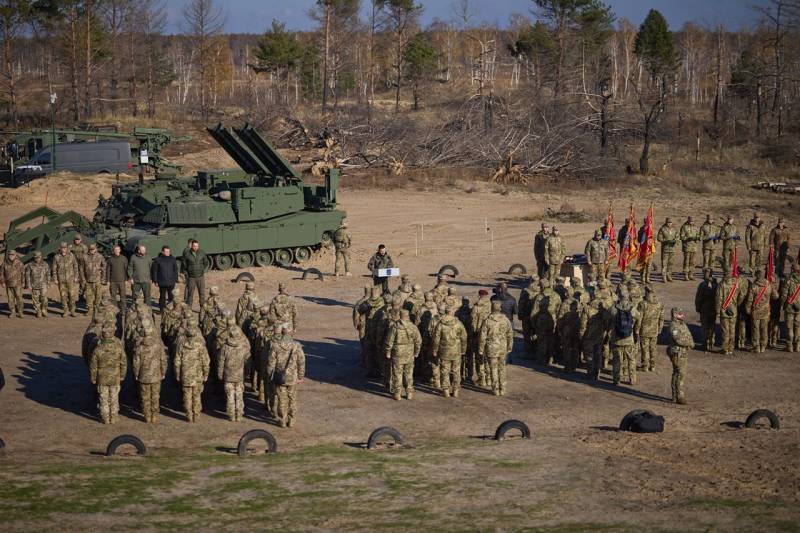
The fact that Ukraine received M1150 ABV assault vehicles from the Americans news cannot be called - unless bearded, since this became known in early November. Therefore, the fact of the transfer itself is pointless to discuss, but we need to talk about what these heavyweights are, who may soon take part in battles. Moreover, they do not at all live up to the title of a simple, cudgel-like minesweeper.
First of all, it should be noted that, despite the designation “assault vehicle” or “assault breakthrough vehicle” (ABV – Assault Breacher Vehicle) being incomprehensible to Russian-speaking readers, the M1150 is essentially an armored mine clearing vehicle. It is intended for making passages in minefields and various kinds of obstacles of man-made and non-man-made origin. Including under enemy fire.
M1150 is a relatively new product if we consider its age from the point of view of engineering technology. Its development started at the beginning of the 1150s at the request of the US Marine Corps. The first six prototypes of the M2002 were manufactured between 2006 and 2008, and already in XNUMX, after final tests, the vehicle was put into service. She managed to fight in Afghanistan, served in South Korea, and now came to Ukraine.
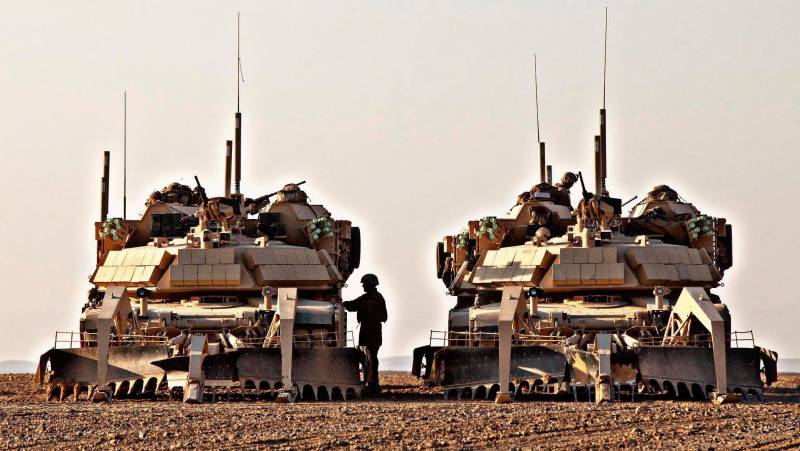
Like its failed predecessors, the M1150 is based on the M1 Abrams. For this Tanks were removed from storage, underwent major repairs and were sent for modification, or rather, for disassembly: from the tank, the manufacturers of this vehicle required only a chassis with a hull without a turret.
No radical changes were made to these parts, so the M1150 is unified with the Abrams in most of the main components and assemblies, as well as spare parts. It has the same 1-horsepower gas turbine engine with automatic transmission, allowing it to accelerate to 500–60 kilometers per hour and overcome uneven terrain with relative ease. And the hull armor has remained the same and in the forehead reaches 65–500 mm from sub-caliber shells and up to 600 mm from cumulative shells, according to various estimates.
But instead of the original turret, a massive, large-sized superstructure was installed on the tank’s chassis, which in weight turned out to be not much less than what was originally installed, based on which the total weight of the fully equipped M1150 is about 58 metric tons (65 “short”). The superstructure has mobility and can be rotated 90 degrees to the right and left, and is also divided into two compartments: front and rear.
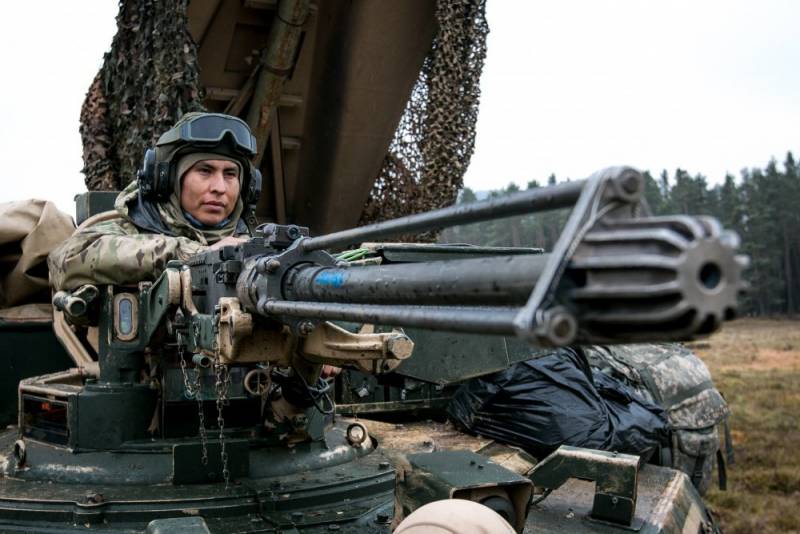
Vehicle commander behind a 12,7 mm machine gun mount
The front compartment, reminiscent in outline of the frontal part of the Abras turret, is fully armored and equipped with dynamic protection. In the middle there is a workplace for the vehicle commander with controls for mine action equipment, electronics and communications. The only thing on the roof weapon M1150 in the form of a machine gun mount with a 12,7 mm Browning, as well as elements of an integrated technical vision system.
This system is a set of television cameras installed in the aft and frontal parts of the superstructure. With their help, the commander, without leaning out of the hatch, can fully control the mine clearance process, including monitoring the depth of penetration of knife trawls into the ground, and the removal of mines torn from it from the track. The system also includes a commander’s observation device, consisting of a moving unit of television and infrared cameras with a laser rangefinder for monitoring the terrain at any time of the day and more accurate “aiming” during remote mine clearance.
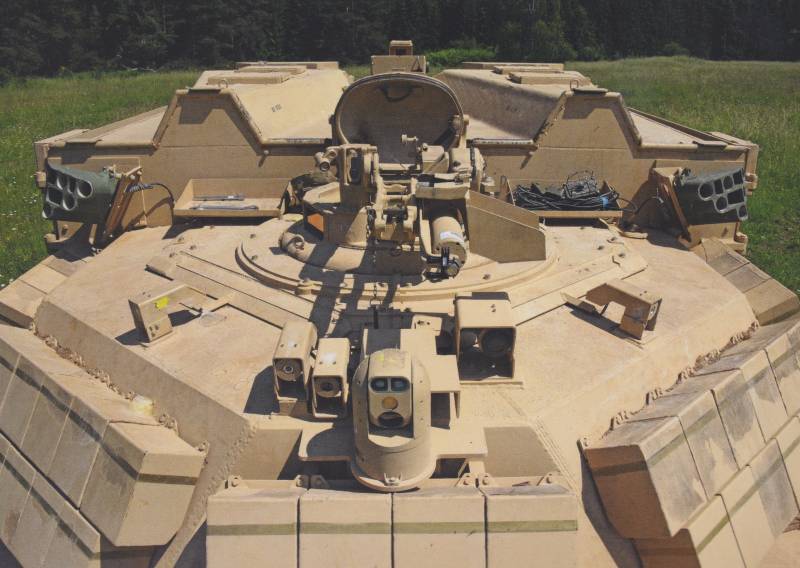
Elements of an integrated technical vision system. Launchers for concealed aerosol grenades are visible behind
By the way, about the remote mine clearance complex. It is located in the rear compartment of the superstructure and is represented by two launchers for M58A3 MICLIC charges, which transform from traveling to combat state (and vice versa) using hydraulics.
Its operating principle is simple. The launchers contain MK22 Mod 4 rockets with charges attached to them, which are 107-meter fabric “sleeves”, equipped with a detonation cable and filled with explosives - 2,2 kilograms of explosives for every 30 centimeters of length (a total of about 790 kg per one charge).
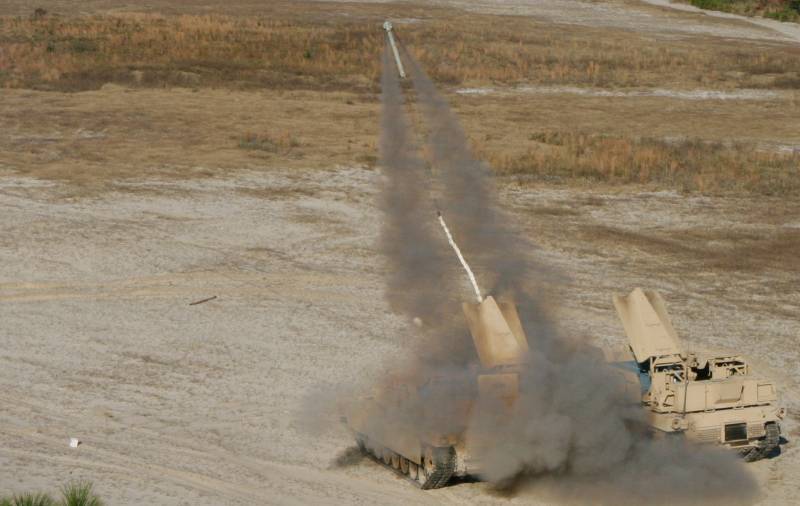
Launching a demining charge
Taking off from the launcher, the projectile pulls a multi-meter charge along its entire length and is disconnected from it at the final stage of the flight. Then the charge that has fallen to the ground is straightened with the help of a brake cable and a command is given to detonate it.
Its detonation leads to the destruction (explosion) of the most common anti-tank and anti-personnel pressure mines, and the dimensions of the cleared area are approximately 100 meters in length and about 8 meters in width. So, taking into account the M1150’s ammunition load of two M58A3s, the total length of passage through the minefield can be 200 meters.
Launching an M58A3 demining charge from an M1150
However, this method of mine clearance does not bring 1150% results - some mines remain lying there, waiting for their target. Especially when it comes to explosive devices with a detonator mechanism different from the push mechanism. And it is unlikely that the MXNUMX would have made a full-fledged minesweeper if it had not been equipped with other mine action equipment. And he has it.
When converting Abrams into M1150, a so-called High Lift Adapter (HLA) or in Russian - “high lift adapter” is installed on their frontal part of the hull. Operated by a driver, it is a hydraulic mechanism that provides for the quick installation of trawls and other “body kit” with the ability to quickly reset them in an emergency without leaving the car.
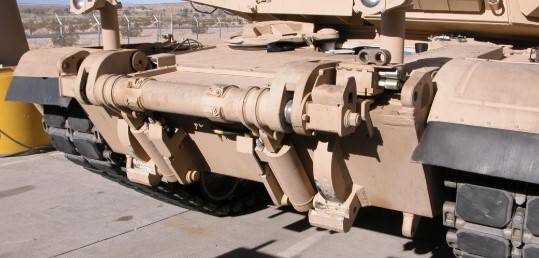
"High lift adapter" on M1150
First of all, it is intended for installing a knife mine trawl, consisting of three sections - two side and one central with nine and five knives, respectively. By the way, it was because of him that the M1150 received the nickname Shredder, which translated means “shredder” or “shredder.”
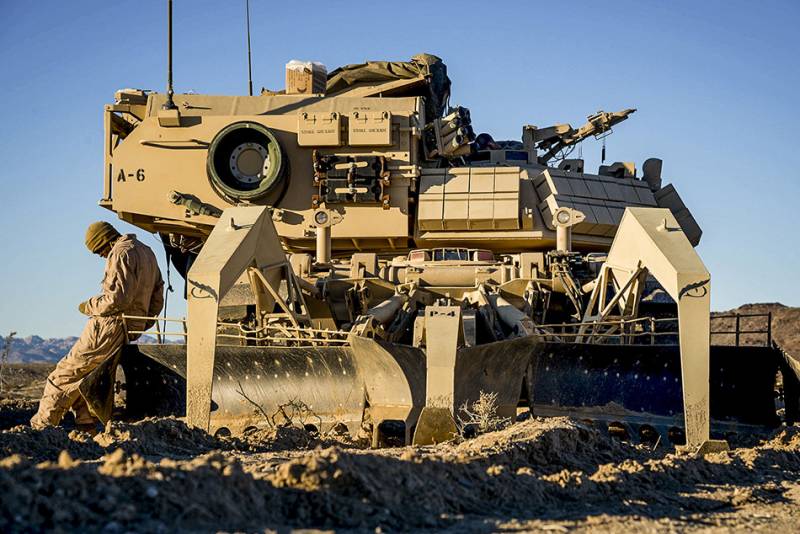
Knife mine trawl on M1150
By cutting into the top layer of the earth, the knives literally plow up the soil and pull out buried mines from it, throwing them away from the track. The same thing happens with explosive devices lying on the surface - they are thrown aside in the same way. And the level of depth of the knives (constant depth 36 cm) is adjusted using three skids on which the trawl rests with the help of racks similar to spider legs.
Also, instead of a trawl, the “adapter” provides for the installation of an ordinary bulldozer blade. In this case, the functionality of the M1150 expands to making passages in rubble and various kinds of obstacles, or, conversely, creating them, digging positions for firing points and digging anti-tank ditches, etc. In general, everything that a minesweeper cannot do, but a bulldozer can do.
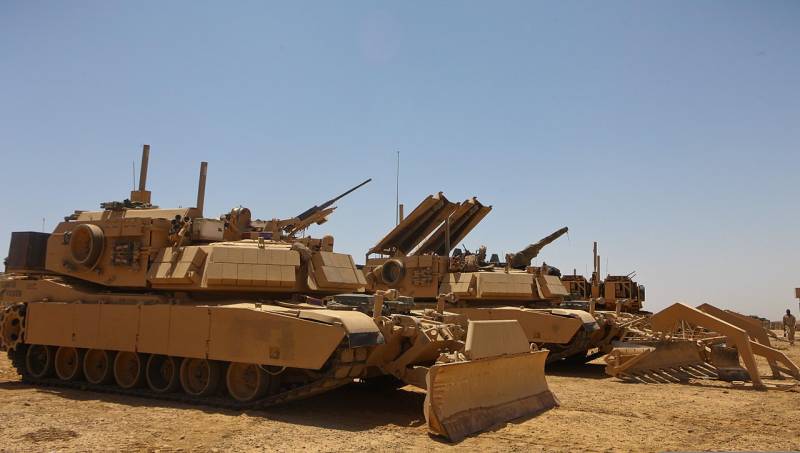
M1150 with a bulldozer blade (closer to the camera) and a knife trawl (farther)
Well, to mark the passages that the M1150 made with either a trawl or a blade, the Lane Marking System is used, or in Russian - a lane/passage/path marking system. It consists of two pneumatic devices installed on the sides of the vehicle in the rear part of the hull.
Each of them contains 50 signal flags (can be replaced with LED or reflective indicators), which, when the vehicle moves, are shot into the ground at regular intervals, thereby marking a safe path for units. However, with the same success they stick even into asphalt and concrete, which is facilitated by powerful pneumatics and metal tips.
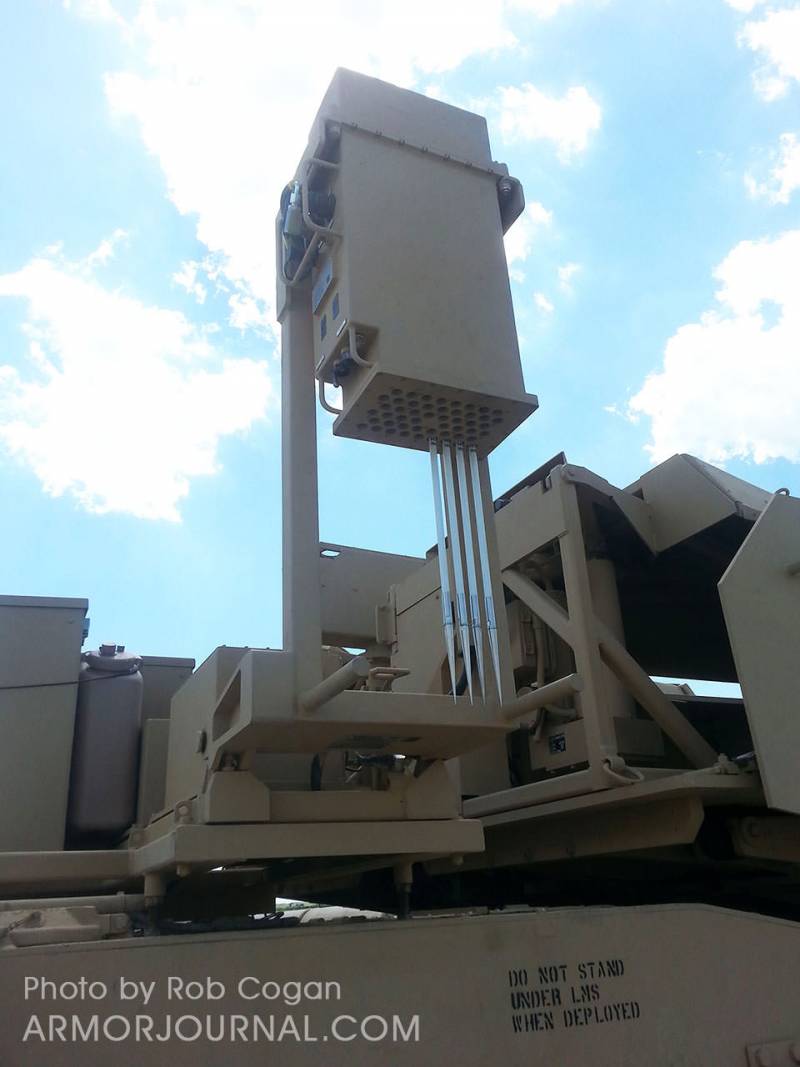
Pneumatic installation for marking a safe path
Overall, of course, the car is quite interesting. The Americans themselves called it the best they have in terms of front-line mine countermeasures. This is understandable: the M1150 has armor, and it’s also supplemented with dynamic protection; there is a full set of equipment to counter most mines, with the exception of any exotic ones; everything is in order with the surveillance equipment - after all, these are not blind-sighted moles, which many BIS are, especially of the Soviet type.
In this regard, it becomes clear why the United States sent this gift to Ukraine. Kyiv, of course, can dispose of it in any way, but, most likely, the purpose of the arrival of the M1150 is to complement the delivered Abrams tanks. Overseas they are well aware that Russian minefields have become one of the most significant threats to armored vehicles, and they do not wish the fate of the Leopard-2s with their “broken legs” to their tanks.
Now all that remains is to see where and when the M1150s show up at the front. But, given the experience of the “counter-offensive”, there are some doubts that their fate will be prosperous - an abundance of anti-tank missiles, aviation and artillery can ruin even the best equipment.
In general, as they say, we’ll see.
Information